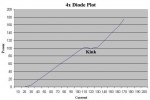IgorT
0
- Joined
- Oct 24, 2007
- Messages
- 4,177
- Points
- 0
Thank you again, Kage and Jay, for alerting me about this diode! I hope what you're getting in the mail expresses my gratitude... 
As i said, Susie was very cooperative with this little project. She misunderstood my doubts about the diode (i thought it was a harvested PHR), and was genuinelly worried, that the factory she got it from (not her factory) is lying about it. So she offered to split the cost of the sample with me, just in case the results would be bad. (Thank you for that Susie!)
But i asked many questions before paying, she answered them all, and from the story alone, i was sure the diode is real. I asked for it to be factory sealed in ESD bag, and it was - the laser show factory prepared the sample flawlessly. I asked for photos of the packaged sample, before sending PP, and i got that too, and by the time i paid, i had no doubts, this diode would not only be good, but would teach us a lot as well!
We finally have a 405nm diode WITH a datasheet! ;D
As i said, Susie was very cooperative with this little project. She misunderstood my doubts about the diode (i thought it was a harvested PHR), and was genuinelly worried, that the factory she got it from (not her factory) is lying about it. So she offered to split the cost of the sample with me, just in case the results would be bad. (Thank you for that Susie!)
But i asked many questions before paying, she answered them all, and from the story alone, i was sure the diode is real. I asked for it to be factory sealed in ESD bag, and it was - the laser show factory prepared the sample flawlessly. I asked for photos of the packaged sample, before sending PP, and i got that too, and by the time i paid, i had no doubts, this diode would not only be good, but would teach us a lot as well!
We finally have a 405nm diode WITH a datasheet! ;D






